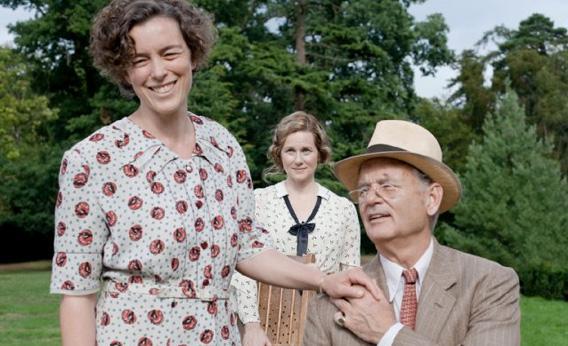The hand job in Hyde Park on Hudson (Focus Features) really arrives from out of the blue. There you are, watching Bill Murray as Franklin Delano Roosevelt and Laura Linney as Margaret “Daisy” Suckley, his distant cousin and eventual longtime mistress, take a picturesque country drive in the president’s car in the early days of their acquaintance. Glenn Miller’s “In a Sentimental Mood” plays on the radio as they park in a field of vibrant lavender flowers, share a cigarette, and all of a sudden … well, when FDR’s convertible is rockin’, don’t come a-knockin’.
That scene, shot from discreet angles that nonetheless give you a crystal-clear sense of what’s going on in the president’s pants, is perhaps the emblematic moment of Hyde Park on Hudson, a would-be prestige biopic that’s a weird amalgamation of primness and prurience. The production and period costume design are impeccably realized in that slightly too-pretty Downton Abbey fashion, the Roosevelt family mansion and its stately grounds filmed through a scrim of golden haze as the Ink Spots croon on the soundtrack. Yet the film’s story focuses with a puzzling degree of exclusivity on questions involving, in one way or another, the presidential peter. In addition to the evolving relationship between FDR and Daisy, there’s a significant subplot—or was it intended as the main plot?—about the King and Queen of England’s visit to Hyde Park in the summer of 1939, as the royals were seeking to stir Roosevelt from his isolationist stance toward the impending war. But in director Roger Michell’s vision of this historic encounter, the fate of the free world hinges on whether the impish president can persuade George VI (Samuel West)—the same stuttering monarch played by Colin Firth in The King’s Speech—to bite into an explicitly phallic hot dog at a picnic.
It’s not that Hyde Park on Hudson’s aim is to portray the 32nd president as a do-nothing perv. The film is generally laudatory in its portrait of the savvy, tenacious man who held America together through the Great Depression and World War II. It’s just that we don’t hear much about FDR’s character or accomplishments in Richard Nelson’s screenplay, which is too softheaded to have anything like a political agenda. Instead, the viewer is trapped in the singularly dull romance between FDR and Daisy—a “romance” that unpleasantly resembles sexual exploitation, with the president blithely using the naïve, none-too-bright Daisy for sex and pleasant company while she entertains fantasies of the two of them running away together. Laura Linney has never played someone this uninteresting; it’s as if she and the filmmakers deliberately tried to make Daisy Suckley a character devoid of the slightest trace of vivacity, intelligence, or charm—too wan and po-faced even to hate. (Warning: She has an extensive voiceover.)
When the focus all-too-briefly shifts away from this wet sock of a protagonist, there are flickers of incipient life in Hyde Park on Hudson. Olivia Williams plays Eleanor Roosevelt with a warm, dry wit and somehow even manages to hold her face so that she slightly resembles the famous first lady, without any digital or latex augmentation. The scenes between the king and the president, when not preoccupied with hot dogs or ill-concealed booty calls, can sometimes show a flash of political intelligence. In the movie’s sharpest moment, the press-savvy FDR expertly lays out for the flustered king what’s at stake in the royal visit (which, amazingly, was the first time a sitting English monarch had ever been to the Western Hemisphere).
I wish I could say that Bill Murray’s performance as FDR was so wonderful it transcended the material, but the truth is that Murray’s character never fully emerges from the fog (and neither does his accent, which takes a well-meant but painful stab at recreating FDR’s trumpet-like mid-Atlantic drawl). Murray does manage to communicate some sense of the president’s interiority—we get that his lively social wit masks a lonely, closed-off guy who craves undemanding female company, and not only Daisy’s but that of a rotating harem of mistresses, including his personal secretary, Missy LeHand (Elizabeth Marvel). But FDR serves, maddeningly, mainly as backdrop for the front-and-center pining of Daisy the Drab. We barely get a glimpse of FDR’s complicated domestic relationship to Eleanor and only one scene that more than glancingly references his struggle with the disability he hid throughout his presidency for fear of the shame of being seen in a wheelchair. And if you’re hoping to use this movie to cram for that upcoming history final on the New Deal or the Munich Pact, better downgrade those expectations right now. Hyde Park on Hudson has little more on its mind than hot dogs and hand jobs—which, come to think of it, would have made for a much catchier alliterative title.
